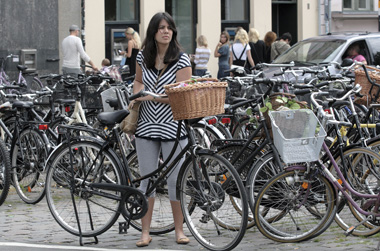In Copenhagen, exiting a cab always elicits the same remark from the driver: "Watch out for the bicycles!"
That's because in this city the bikes are the dominant form of transport, and they don't stop for anyone. The way the Danes have developed their bicycle infrastructure is a lesson we could benefit from here in New England. I can feel a shift, a willingness to treat bikes with the same respect as other vehicles, but we've got a long way to go. Here is how to get started:
Start with the basics. In Denmark, bike lanes are taken seriously enough so that they install a paved hump between bike lanes and car lanes. As a result, there are no pedestrians in the bike lanes, only full-steam-ahead, seriously-on-their-way bikers. Cars, too, feel the bump and stay out of the bikes' way.
When bike riders in the United States act as if stop signs don't apply to them, it infuriates drivers. In Denmark, the bicyclists give something in return. At each crosswalk there are red and green traffic lights just for the bikes. For the most part the bikers respect these, so the traffic system works. They don't keep pedaling when a red light flashes before them.
In the Netherlands, where 40 percent of the population use bikes as the primary commuting vehicle, they've figured out that when traffic is slower than about 18 miles per hour, bikes can integrate safely with cars; at higher speeds, bikes need to be separated from cars.
In the U.S., bike paths fill up on weekends with Lycra-clad recreationalists, but are often much less used during commuting hours. In Denmark, one sees relatively few cyclists obviously using bikes for pure recreation. Danish cyclists have to get to work, so they're pedaling in suits or dresses, even high heels.
The Danes use their bikes to go out to dinner, see a movie, or visit relatives across town. So bikes in Denmark are equipped much differently. The seats are broad and comfy, not styled as a tight vee. On the back there is a sturdy welded rack, capable of easily accommodating a passenger in a pinch. Then there are the lights. The vast majority still favor the old dynamo style that grinds against your tire to generate electricity for the back red light and front headlamp.
A newer type of bike light is more clever. A light is bolted next to the front and rear axles and two magnets spin on the spokes, rotating to create energy inside the lamp, so that both back and front lights flicker as the wheel spins.
Danish cyclists sometimes need to be able to carry more than just one rider, so modified bikes carry up to three extra passengers. The Cycle Mom-mobile is the most popular. Up front, a big box runs on two wheels, and it looks like something you might see in Chinatown, delivering noodles. Two tykes pile into the box and mom pedals. Then there is the utility trailer. The pedaler pushes a giant freight box, hauling whatever he needs like a train pushing the caboose first.
If you don't have a bike in Copenhagen, no problem. The city has installed 1,500 city bikes that they loan to the public. A 20 kronor ($3.60) coin is popped into a lock and you get the money back when you park the bike in the city bike zone for the next user. On a recent visit, I finally took to the bike lanes myself. I borrowed a woman's three-speed from our hotel and set off, falling into the stream of bike traffic on the busy boulevard. It was wonderful. We only stopped for the traffic lights.
Max Hartshorne is the owner of GoNOMAD Café in South Deerfield. He sometimes bikes to work.



